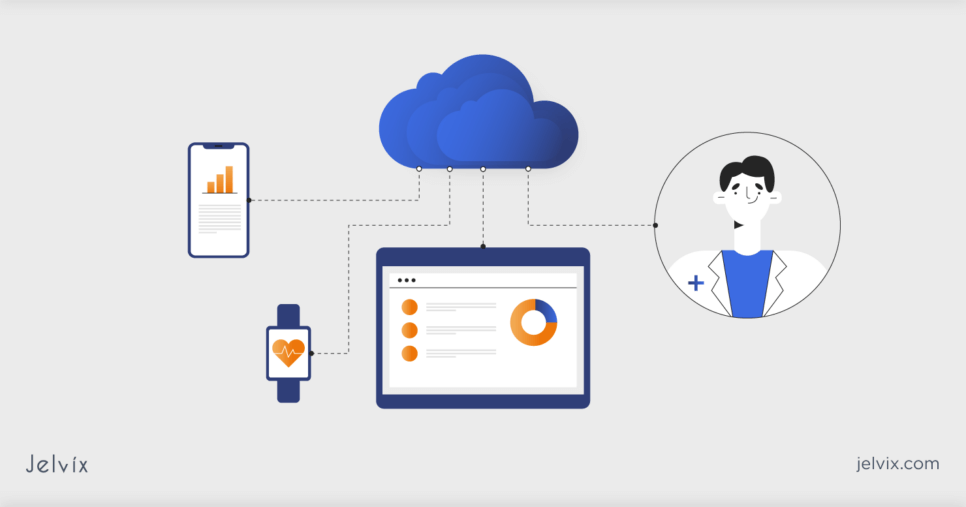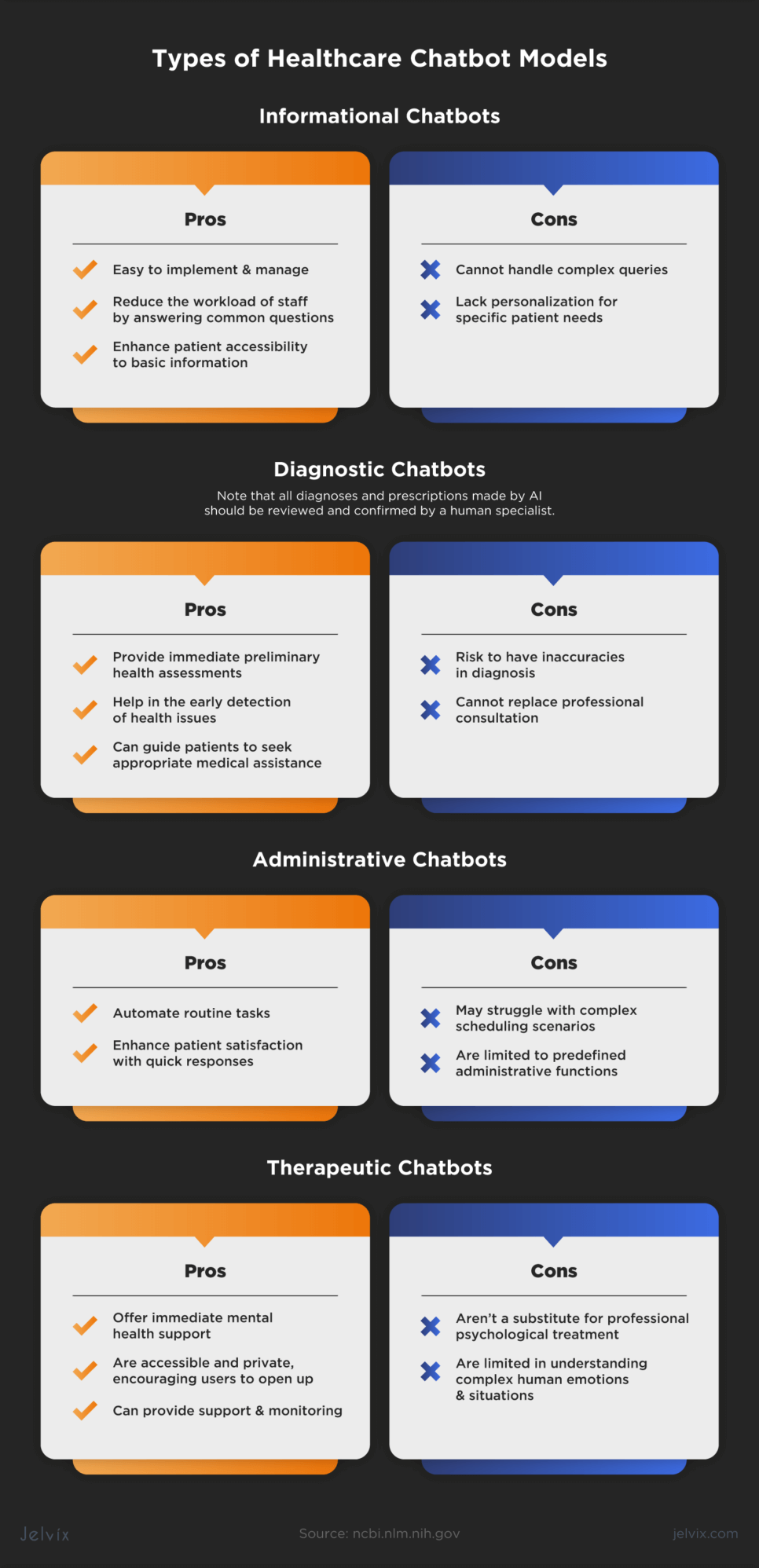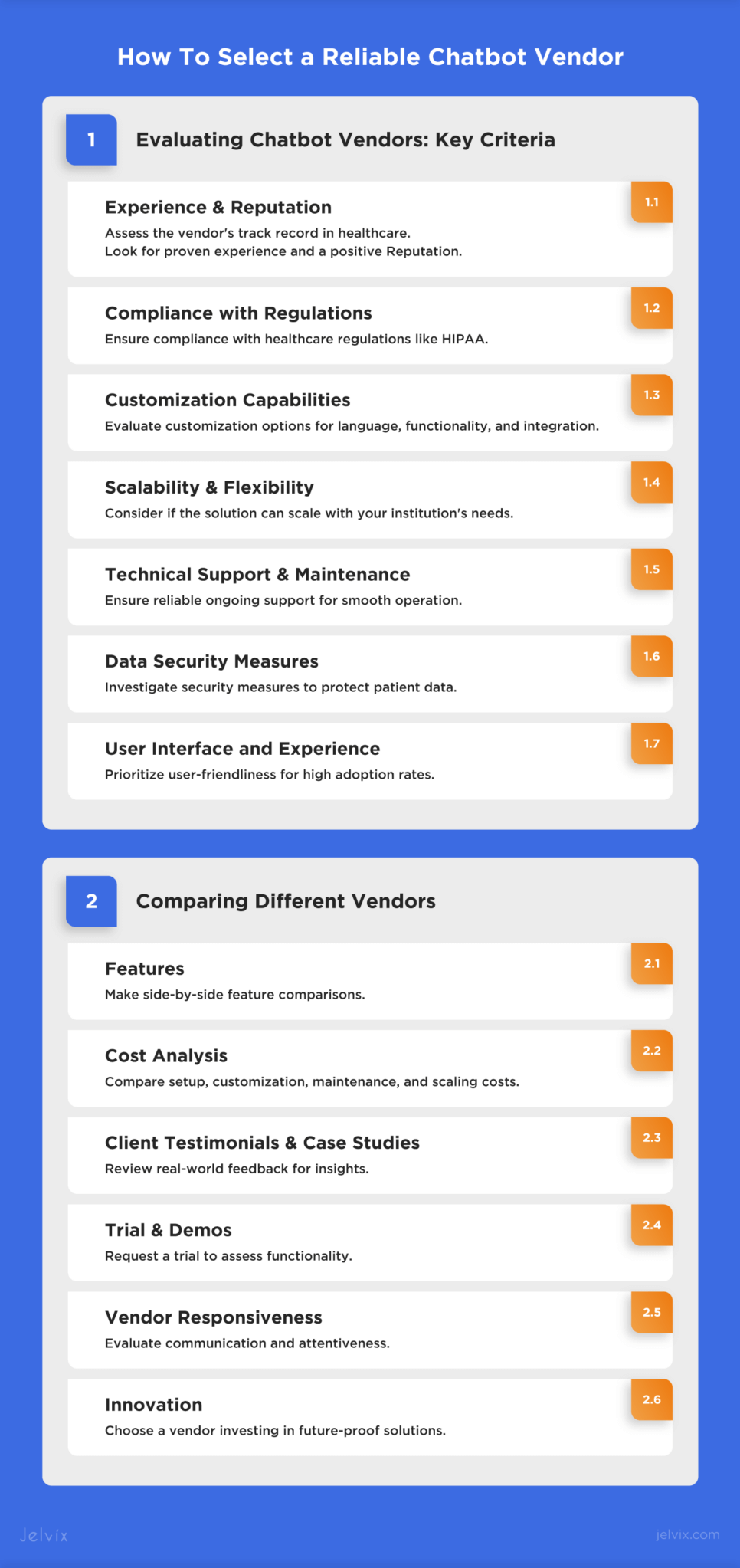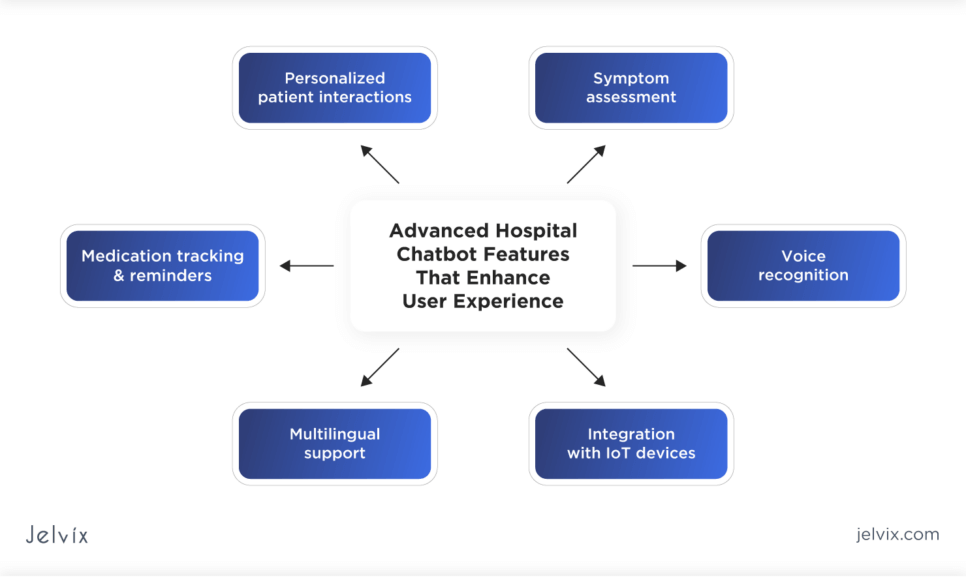Chatbots are being widely adopted in the healthcare industry. According to the Data Bridge Market research, the medical chatbot market was estimated at USD 248.93 million in 2022 and will reach USD 1179.81 million by 2030.
The impact of AI-powered chatbots on healthcare promises to be transformative, as they save medical institutions time and costs by offering 24/7 support to patients, assisting physicians in providing customized care, and handling administrative tasks.
However, choosing the right chatbot for hospitals can be more complex than it seems. The key challenge lies in selecting a solution that aligns with the specific requirements of a healthcare entity and ensures effective communication, data security, and regulatory compliance.
If you’re a healthcare provider struggling to choose a chatbot for your organization, read this article. You’ll discover tips on evaluating chatbot features, learn to compare them to your organization’s needs, and find out the essential steps for successful chatbot implementation.
Assessing Your Institution’s Specific Requirements
Before getting to know what chatbot options are available, it’s essential to evaluate your healthcare institution’s needs. This assessment will inform your decision and ensure that the chatbot you choose aligns with your goals and challenges.
Key Areas for Medical Chatbot Integration
Chatbots can be integrated for numerous purposes that vary from clinic to clinic. Make sure you understand the aim of chatbot implementation for your healthcare entity:
- Patient interaction: chatbots can provide continuous responses to general inquiries or handle complex health-related questions;
- Administrative tasks: they automate administrative tasks, such as appointment scheduling, processing patient intake forms, and collecting feedback;
- Clinical support: chatbots are capable of offering clinical support, conducting symptom checks, sending medication reminders, and providing post-operative care instructions;
- Staff assistance: a chatbot can support medical staff by facilitating patient data collection or offering quick access to medical records and treatment plans;
- Patient engagement and education: chatbots can offer educational resources, promoting patient engagement and contributing to better health outcomes.
Types of Healthcare Chatbot Models
Although the best healthcare chatbots improve overall care delivery, they can be divided into various types that differ in functionality and healthcare goals.
Informational Chatbots
Informational chatbots provide general information to patients, such as clinic operating hours, services offered, and basic health education. They are typically used for handling routine inquiries.
Pros:
- Easy to implement and manage;
- Reduce the workload of staff by answering common questions;
- Enhance patient accessibility to basic information.
Cons:
- Cannot handle complex queries;
- Lack personalization for specific patient needs.
Diagnostic Сhatbots
These chatbots assist in preliminary diagnosis by analyzing symptoms and suggesting possible medical conditions. They use advanced AI algorithms to simulate a basic medical assessment. You can use a database of symptoms and medical conditions, map out the conversation paths the chatbot will take, and set up response templates to establish a clear chatbot workflow. Note that all diagnoses and prescriptions made by AI should be reviewed and confirmed by a human specialist.
Pros:
- Provide immediate preliminary health assessments;
- Help in the early detection of health issues;
- Can guide patients to seek appropriate medical assistance.
Cons:
- Risk to have inaccuracies in diagnosis;
- Cannot replace professional consultation.
Administrative Chatbots
Specialized in managing administrative tasks like appointment scheduling, patient intake, and feedback collection, these chatbots are designed to streamline operational processes.
Pros:
- Automate routine tasks;
- Enhance patient satisfaction with quick responses.
Cons:
- May struggle with complex scheduling scenarios;
- Are limited to predefined administrative functions.
Therapeutic Chatbots
Primarily used for mental health support, therapeutic chatbots offer coping strategies, conduct initial assessments, and provide basic therapeutic interactions.
Pros:
- Offer immediate mental health support;
- Are accessible and private, encouraging users to open up;
- Can provide support and monitoring.
Cons:
- Are not a substitute for professional psychological treatment;
- Are limited in understanding complex human emotions and situations.
Although some AI chatbots can assist physicians in creating personalized treatment plans, all the recommendations provided should be reviewed by human specialists.
Essential Functionalities of an Effective Chatbot in Healthcare
A chatbot’s functionalities can be categorized into two primary aspects: key features that are must-haves and advanced functionalities that healthcare providers can implement depending on their needs and possibilities.
Key Features To Look for in a Healthcare Chatbot
Each chatbot should have a set of key features that make sure it works efficiently and safely:
- Compliance and security: chatbots should adhere to standards, such as the Health Insurance Portability and Accountability Act (HIPAA), to maintain the security and confidentiality of patient data;
- Natural Language Processing capabilities: a chatbot with NLP can understand and interpret a wide range of human languages and nuances, making interactions more natural;
- EHR integration: ensure a chatbot can integrate with existing systems, including Electronic Health Records, to deliver functionality and information accessibility;
- Scalability: a medical chatbot should handle an increasing number of interactions and expand its functionalities as the healthcare institution’s needs grow and change;
- User-friendly interface: an easy-to-use interface accessible to individuals of all ages and levels of tech-savviness will ensure ease of use for a broad patient base;
- Customization: a chatbot should be capable of tailoring interactions to individual patient needs and preferences, enhancing the effectiveness of its responses and engagements.
Advanced Hospital Chatbot Features That Enhance User Experience
The sophisticated and sensitive nature of medical interactions may require additional functionality to make interactions more personalized, intuitive, and effective. Healthcare providers should take into account the following features:
- Personalized patient interactions: a chatbot can provide personalized responses based on the patient’s medical history;
- Symptom assessment: chatbots can help physicians assess symptoms and offer preliminary guidance;
- Medication tracking and reminders: a chatbot can track medication schedules and send reminders;
- Multilingual support: offering support in multiple languages can enhance accessibility and user experience;
- Voice recognition: the voice recognition technology allows for hands-free operation, which can be beneficial for patients with mobility or vision impairments;
- Integration with IoT devices: by connecting with wearables, chatbots can access real-time health data for accurate health monitoring.
Compliance and Security Considerations
In healthcare, where patient data is highly sensitive, compliance and security for chatbots are non-negotiable. Ensure that your chatbot adheres to the following regulatory standards:
- HIPAA compliance: as noted earlier in this article, healthcare chatbots must comply with HIPAA regulations to ensure the secure handling and confidentiality of patient data;
- EU AI Act: this is a newly issued regulation that ensures AI technologies are used safely and effectively, respecting patient privacy and ethical standards;
- Data encryption: strong encryption for data both at rest and in transit is crucial to protect patient information and ensure secure chatbot communication;
- Security audits and updates: regular security audits and updates are necessary to identify and address vulnerabilities, keeping the chatbot secure against emerging cyber threats;
- Patient consent management: chatbots should manage patient consent effectively, particularly for data collection, processing, and sharing;
- Emergency protocols: chatbots must have protocols for human intervention in case of emergencies, ensuring patient safety;
- User authentication and access control: robust authentication and access control, including secure login systems and role-based access, are vital to prevent unauthorized data access;
- Audit trails: maintaining detailed logs of all chatbot interactions and data access aids in monitoring and detecting any potential breaches.
How To Select a Reliable Chatbot Vendor
Choosing the right tech partner for chatbot development and training involves the evaluation and comparison of various vendors to ensure that the chosen solution aligns with the clinic’s specific needs and compliance standards.
Evaluating Chatbot Vendors: Key Criteria
The Jelvix team recommends to pay attention to the following aspects when choosing a chatbot vendor:
- Experience and reputation: assess the vendor’s track record in the healthcare industry. Look for vendors with proven experience and a positive reputation in creating healthcare chatbots;
- Compliance with regulations: ensure that the vendor’s chatbot solutions comply with healthcare regulations like HIPAA;
- Customization capabilities: evaluate the extent to which the vendor can customize the chatbot according to your specific requirements, including language, functionality, and integration with existing systems;
- Scalability and flexibility: consider whether the vendor’s solution can scale and evolve as your institution’s needs change over time;
- Technical support and maintenance: make sure that the vendor offers technical support and maintenance services. Reliable ongoing support is crucial for the smooth operation of the chatbot;
- Data security measures: investigate what security measures the vendor offers to protect patient data. This may include data encryption, secure data storage, and regular security audits;
- User interface and experience: look at the user-friendliness of the chatbot. A good user interface and a seamless user experience are important for ensuring high adoption rates.
Ensure success and discover essential tips for selecting the right tech partner in our comprehensive guide.
Comparing Different Vendors
By comparing different vendors, healthcare providers can select the most relevant solution. The Jelvix team recommends to compare vendors by at least 6 parameters:
- Features: make a side-by-side comparison of the features offered by different vendors and prioritize the most relevant ones;
- Cost analysis: compare the costs, including setup, customization, maintenance, and scaling. Calculate the return on investment in the long term;
- Client testimonials and case studies: review real-world testimonials and case studies to get valuable insights into the effectiveness of a chatbot;
- Trial and demos: request a trial or demo to see the chatbot in action. This can help assess its functionality and suitability for your institution;
- Vendor responsiveness: assess the responsiveness and communication skills of the vendor during the evaluation process. A vendor who is attentive to your needs during the sales process is more likely to provide excellent ongoing service;
- Innovation: choose a vendor who invests in future-proofing their products to ensure that your chatbot will remain relevant and effective.
Integrating Chatbots with EHRs and Other Healthcare Systems: Challenges and Solutions
Integrating chatbots with EHRs and other healthcare systems involves challenges, but with thoughtful solutions, they can be effectively managed.
Challenges of Chatbot Integration with Existing Systems
The key challenges of chatbot integration involve security, compatibility, data complexity, and synchronization concerns.
Compatibility with Diverse Software Platforms
Different healthcare systems use diverse software platforms, which can create compatibility issues for chatbots. Employing middleware or using APIs (Application Programming Interfaces) that are designed to work across multiple platforms can help in bridging compatibility gaps.
Data Security and Privacy Concerns
Ensuring the security and privacy of patient data when integrating chatbots with EHRs is a significant concern. Implementing end-to-end encryption and secure data transfer protocols, along with adhering to HIPAA and other privacy regulations, will help keep patient data safe.
Complexity in Data Structures
EHRs often have complex data structures that can be challenging for chatbots to interpret accurately. Developing data parsing algorithms and using NLP techniques can help chatbots better understand and use complex data.
Real-Time Data Syncing
Keeping the data synced in real-time between chatbots and EHRs can be challenging due to the continuous updates. Implementing real-time data synchronization mechanisms and using cloud-based solutions can ensure that the chatbot operates the most current data.
User Authentication and Authorization
Ensuring that only authorized personnel have access to sensitive data through the chatbot is needed to keep it safe. Consider implementing user authentication and authorization protocols with role-based access controls to maintain data integrity and security.
Scalability and Performance
The chatbot system must be scalable to handle increasing data loads and integration points without performance disruptions. Using scalable cloud services and efficient coding practices can address this issue.
Technical Considerations for Seamless Integration
Integrating chatbots into healthcare systems requires key technical considerations to ensure they function seamlessly and securely:
- API compatibility: verify the chatbot’s compatibility with your clinic’s EHR and other system APIs for smooth data exchange and interoperability;
- Data mapping and standardization: ensure effective data mapping and adherence to protocols like HL7 or FHIR for accurate data interpretation and usage;
- Error handling and reporting: implement robust error-handling and reporting mechanisms to maintain system reliability and facilitate timely issue resolution;
- Testing and quality assurance: conduct thorough testing, including integration and user acceptance tests, before deployment and maintain ongoing quality assurance for system integrity.
By addressing these technical considerations, healthcare providers can ensure that their chatbots enhance patient care, elevate operational efficiency, and maintain the highest data security standards.
Explore the benefits and best practices of integrating chatbots with CRM systems.
The Importance of User-Friendly Design in Healthcare Chatbots
Offering must-have features and complying with industry regulations is essential when developing a chatbot for healthcare. However, healthcare providers shouldn’t underestimate the importance of user interface, as it directly impacts user satisfaction and engagement.
Best Practices for Chatbot Interface Design
Designing an interface for a healthcare chatbot requires focusing on functionality, accessibility, and user engagement. Here are some best practices to consider:
- Clarity and simplicity: keep the interface clean and straightforward. Use simple language and clear, concise instructions to guide users through interactions.
- Responsive and adaptive design: ensure that the chatbot interface is responsive and looks good on a variety of devices and screen sizes, from smartphones to tablets and desktop computers.
- UI patterns: use established UI patterns and common design elements like buttons, menus, and conversational cues to make the chatbot more intuitive.
- Visual feedback: provide visual feedback for user actions. For instance, when a user sends a message, showing a ‘message sent’ indicator helps confirm the action.
- Accessibility: design with accessibility in mind to accommodate users with disabilities. This includes text-to-speech, voice recognition, and high-contrast color schemes for visually impaired users.
Chatbot Implementation Strategy
Implementing a chatbot in a healthcare setting is a multi-step process that requires careful planning and execution. To facilitate this process for you, the Jelvix team prepared key steps to consider for successful and smooth implementation.
1. Define the Purpose and Goals
Establish clear objectives for the chatbot implementation, whether it’s for patient engagement, appointment scheduling, or providing healthcare information. Goals should align the healthcare software development process with the institution’s specific needs.
2. Collect and Analyze the Requirements
Gather detailed information about what users expect from the chatbot. It’s about identifying key functionalities, types of information the chatbot will provide, and the preferred style of interaction.
3. Ensure Compliance with Regulations
Make sure the chatbot complies with healthcare regulations such as HIPAA and GDPR, focusing on the security and privacy of patient data. Compliance is critical for legal adherence and maintaining patient trust.
4. Select an Appropriate Chatbot Platform
Choose a platform that offers necessary functionalities, including integration with EHR systems, scalability, and customization. The right platform ensures the chatbot meets technical and operational requirements.
5. Design a User-Friendly Interface
Focus on creating an intuitive interface with simple language, clear menus, and assistance cues to facilitate ease of use. A user-friendly interface is crucial for high adoption and satisfaction rates.
6. Integrate with Existing Healthcare Systems
Seamlessly integrate the chatbot with existing systems like EHRs for efficient information exchange. This ensures the chatbot effectively handles existing healthcare processes.
7. Develop Training Programs
Create training programs with guides, tutorials, and hands-on sessions for staff and patients to help them adapt to the chatbot. Effective training will maximize its utility and efficiency.
8. Conduct Pilot Testing and Gather Feedback
Test the chatbot in a controlled environment and gather user feedback to identify improvement areas. Pilot testing is essential for fine-tuning the chatbot before broader deployment.
9. Monitor, Evaluate, and Update
Continuously monitor the chatbot’s performance, regularly evaluate its impact, and update it to address new needs and technology advancements. Ongoing monitoring ensures sustained effectiveness.
Key Metrics to Evaluate Chatbot Performance
- Evaluating chatbot performance in healthcare is essential for identifying successes and areas for improvement. Important metrics include:
- User engagement rate tracks the frequency and duration of user interactions with the chatbot;
- Response accuracy assesses the chatbot’s ability to understand and correctly respond to queries;
- User satisfaction scores, obtained through surveys or feedback tools, provide insights into the user experience;
- The resolution rate represents the percentage of queries resolved by the chatbot without needing human intervention.
Assessing the Impact and ROI of a Chatbot
Assessing the Return on Investment (ROI) of a healthcare chatbot involves analyzing qualitative and quantitative outcomes:
- Quantitatively: look at reductions in operational costs, such as decreased staff workload from the chatbot managing routine tasks;
- Qualitatively: evaluate improvements in patient engagement and satisfaction, and consider long-term benefits, such as improved patient сare due to better engagement.
Future Trends and Developments in Healthcare Chatbots
The overall future of chatbots in healthcare looks promising. However, some of the evolving trends step forward to improve the sector.
AI and Machine Learning
According to NBER, AI integration in healthcare could result in 5-10% savings in U.S. healthcare expenses. Сhatbots will increasingly use advanced AI and machine learning algorithms, allowing for more personalized and adaptive interactions with patients and improved decision-making capabilities.
Natural Language Processing
MarketsAndMarkets reports that NLP in healthcare is projected to reach USD 11.8 bln by 2028. The use of more sophisticated NLP techniques will enable chatbots to understand and respond to complex patient queries more accurately, making conversations human-like and natural.
Expanded Roles in Diagnosis and Treatment
Chatbots are expected to play larger roles in preliminary diagnosis and treatment recommendations, using patient data and medical knowledge bases for informed and timely healthcare assistance.
Increased Application in Mental Health Support
Chatbots will be used more frequently in mental health care, offering initial counseling, mood tracking, and providing support for common mental health issues, potentially improving accessibility to mental health care.
Integration with Telehealth
Chatbots in telehealth solutions will streamline the virtual care process, from scheduling appointments to facilitating pre-consultation assessments. They are seen to enhance the efficiency of telehealth services, offering patients immediate assistance and guidance.
Integration of a Custom Chatbot: Jelvix Expertise
As the healthcare sector develops and adopts new technologies, the integration of AI with medical solutions is becoming common. At Jelvix, we acknowledge the challenges of implementing AI-driven chatbots into healthcare practices and are ready to offer customized solutions for unique healthcare needs.
Contact our team if you seek advice on implementing a chatbot into your healthcare settings. They are available to address any queries regarding custom AI-driven solutions.
Exploring a technology partnership?
Explore our healthcare software development services with our expert team. Inquire about training your chatbot today.
















